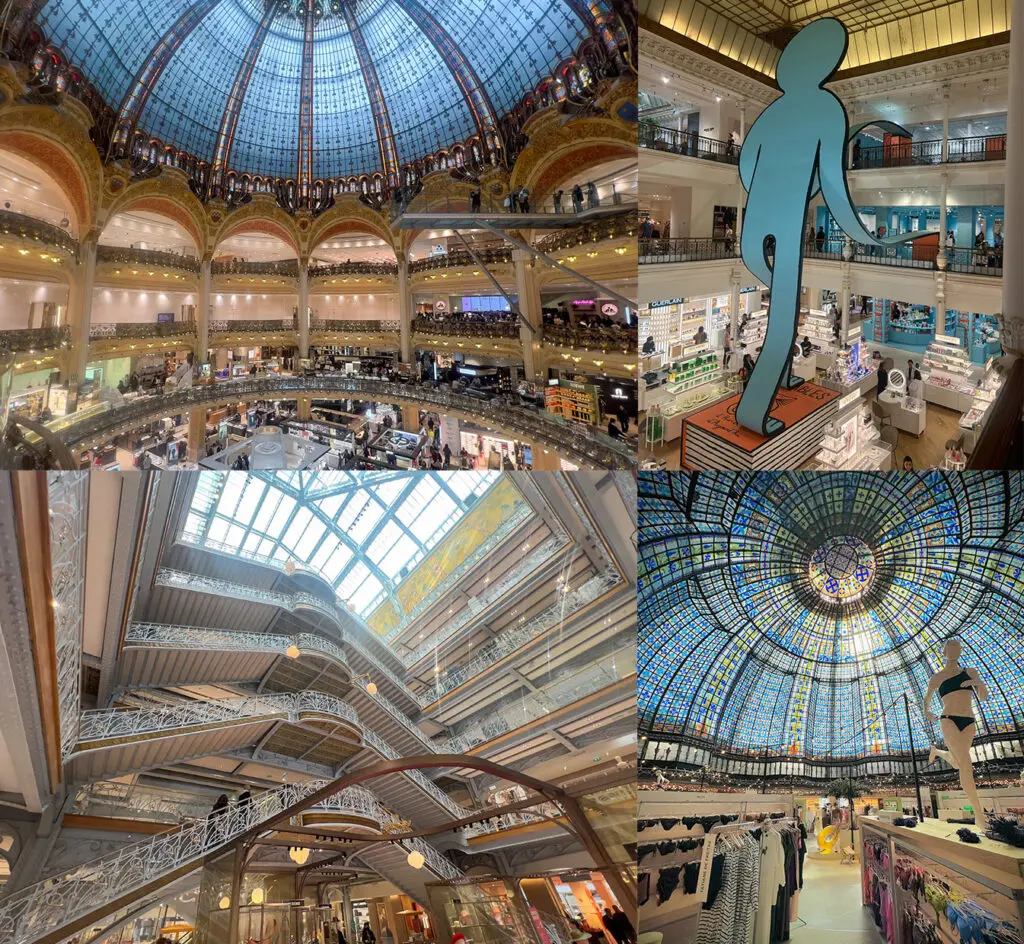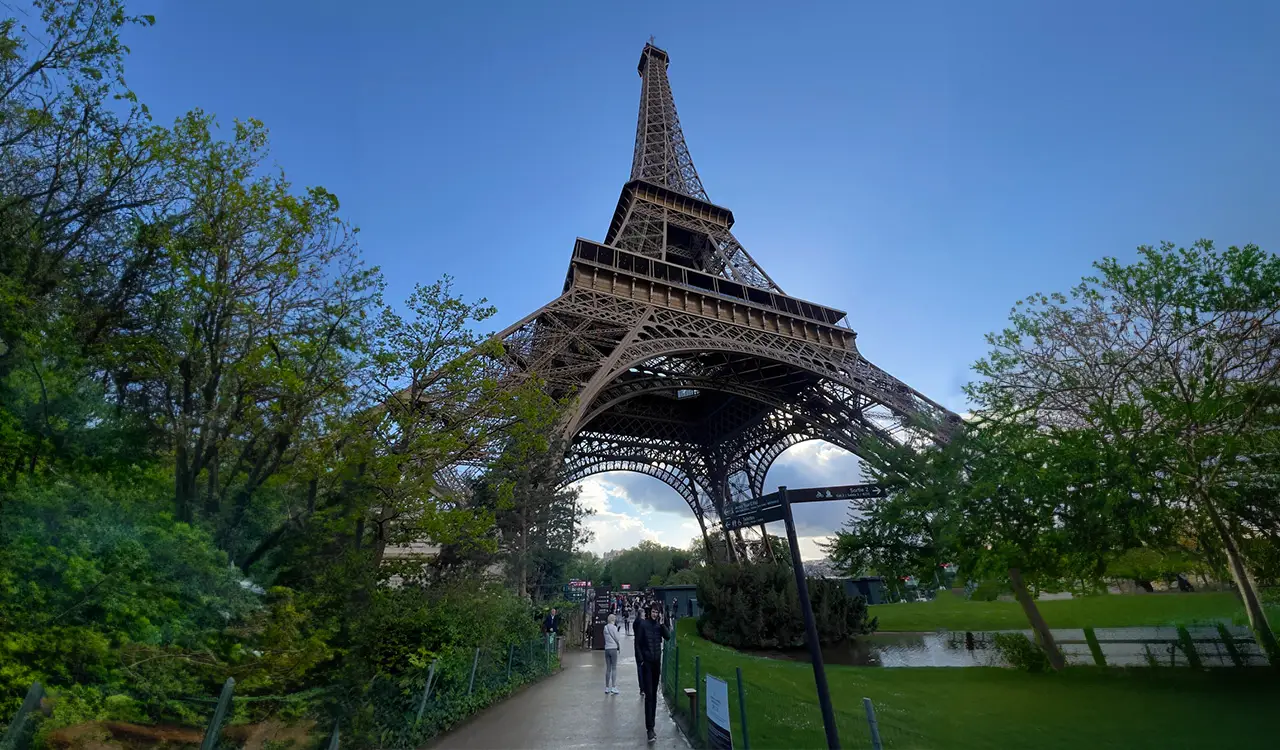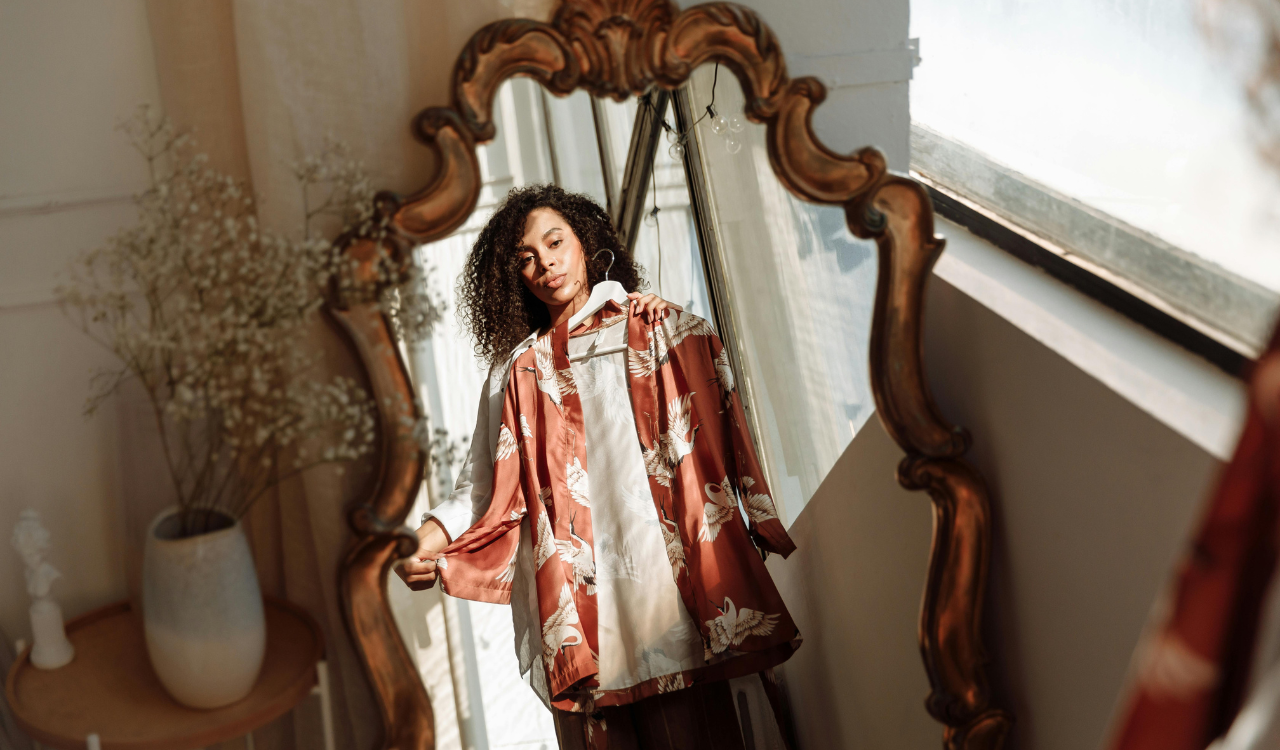The great department store brands in the U.S. and Paris got their start in the 1800s. Seven U.S. brands have closed their doors. Granted mergers and consolidations have changed the retail landscape, but what happened to those American icons and why are today’s physical stores so uninspired compared to the grandes dames in Paris retail?
Pre-Olympics Paris is a scaffolding-dominated cityscape, with freshly cleaned-up building facades and lots of shiny metal bleachers. Notre-Dame is still undergoing renovations with the ambitious goal of being completed for the Olympics. But one thing is for sure. Paris is the place to shop with memorable customer experiences. What’s left of the original 12th -century cobblestoned streets are lined with (mostly empty of shoppers) luxury marques alongside international brands and corner cafes strategically sited where you can recover before your next foray. Dior is the talk of the town with its drop-dead La Galerie Dior retrospective of Christian Dior’s genius celebration of women with color-coded cascades of accessories, muslin models, and his exceptional, original designs. It’s a hugely popular attraction reflecting the blockbuster Dior exhibition staged at the Brooklyn Museum in 2021. Louis Vuitton brightens up the Champs Elysees with a notice-me, photo-printed travel trunk screen to hide its enormous renovation work, illuminated at night like an invitation to fill the giant trunk with every Vuitton luxury imaginable.
And no city in the U.S. can hold a candle to the Belle Epoque grandes dames: Le Bon Marché, Galeries Lafayette, Printemps, and Samaritaine. They all have streets of dreams. That is to say luxury shops, almost to the store showcasing the same brands. These mini boutiques line the perimeters of the stores’ ground floors like sparkling luxe necklaces. The beauty areas feature most of the same brands as well. And all four stores have soaring atriums with ascendant glass dome workmanship dating to the 1800s. It’s the domes that make each of them distinctive
RIP Box Scores
But first for context, here are the great department store brands in the U.S. and Paris that got their start in the 1800s. Seven U.S. brands have closed their doors. Granted mergers and consolidations have changed the retail landscape, but what happened to those American icons and why are today’s physical stores so uninspired compared to the grandes dames in Paris? As a poster child for capitalism and commerce and in its rush to be modern and maximize selling floor space, U.S. department store design has become crammed with merchandise and utilitarian compared to their Parisian sisters. In New York, the 19th century retailers typically take up a full city block with the fortress school of design as compared to the beautiful, airy, light-infused, Belle Epoque architecture of their Parisian counterparts.
The Parisian stores are impressive, memorable, experiential adventures. They may not be perfect when it comes to the omnichannel interface, but the physical stores (where we still do most of our purchasing) transcend transactions as marvels in design and inspiration in tribute to the hope and possibility of refreshing our lives and rewarding ourselves with new things, both nice to have and necessary.
Store design aside, the mortality rate among the iconic American Belle Epoque retailers is 78 percent. Extinct physical store brands are noted in red. We’ll let you draw your own conclusions.
- Lord & Taylor 1826
- Bon Marché. 1838
- Gimbels 1842
- Marshall Field’s 1852
- Carson Pirie Scott 1854
- Macy’s 1858
- Higbee’s 1860
- Wanamaker 1861
- B.Altman 1865
- Printemps. 1865
- Saks Fifth Avenue 1867
- Rich’s 1867
- Samaritaine 1870
- Kaufmann’s 1871
- Bloomingdale’s 1872
- Magnin 1876
- May Company 1877
- Peck & Peck 1888
- Galeries Lafayette 1893
- Belk, 1888
- Sears 1892
- Henri Bendel 1895
- Bergdorf Goodman 1899

A Tale of Four Cupolas
On our recent visit to Paris, we revisited the grandes dames to get a sense of what’s happening in French urban retail. These four historic stores, Le Bon Marché, Printemps, Samaritaine, and Galeries Lafayette continue to bridge 187+ years from the Belle Epoque to the era of AI. We checked them out at all times of the day and can offer the following anecdotal in-store report.
Parisian stores follow the concession model, and apparel is segregated by brands. As you make your way around the perimeter of each store (except Printemps which has no central atrium) you encounter brand after brand segmented in its own boutique. There is a limited selection making what’s available more coveted. Helpful sales reps bring out your size since most everything is racked in size 2, perhaps to appeal to Asian shoppers. And besides, everything looks better when it’s petite, kind of like kittens.
There is an art to shopping in Paris. It helps to know the brands so you can find what you are looking for. A simple example: It’s virtually impossible at these stores to buy a hat. You can get a Fendi bucket or a $60 baseball cap, but finding a selection of all types of hats is impossible. And if you’re a mix-and-match customer, it becomes a challenge to blend different brands, especially when they are yards apart spanning across a vast expanse of open space under a dome.
They all have restaurants, outdoor terraces, and snack shops and most have prerequisite food halls. They are more than stores; they are cultural institutions as the spirit of Paris past and present. And the experience of shopping in the grandes dames is not unlike visiting the Guggenheim as you progress upward through the ring of floors by escalator all filled with desirable possibilities. On our visits, there were very few Asian shoppers and traffic was sparse. We don’t want these icons to become architectural museums. It begs the question: where are all the shoppers? It couldn’t be great news for the retailers, but it made our visits less frantic and stressful.
Samaritaine
Closing its doors in 2005 and then more recently after nearly seven years of renovation, LVMH’s investment in Samaritaine’s facelift shows in the store when it reopened in 2021. Of the four, it is the most elegant and serene. Kevin Roche was SVP of Design and Construction for DFS Group | LVMH and says that with an iconic location near Pont Neuf and as a one-of-a-kind destination, Samaritaine blurs the lines among commercial, retail, and hospitality. It is a sophisticated, well-heeled, grande dame of a store. It is light and airy; the bespoke atrium is ringed by gorgeous art nouveau artwork, and the top floor also serves as a party space. The pale grey ironwork gives the overall effect of being in a feminine birdcage. Its own street of dreams of luxe boutiques have all the expected luxury brands. The lower level is a concoction of beauty and spa services. The upper floors are filled with concession boutiques with many brands you can also find at Nordstrom and Bergdorf. The whole vibe is quiet, understated luxury. There’s something to be said about the circular layout, with appealing vistas across the expanse of the store space with so much luxury waiting to be taken home. But there is a theatrical quality to Samaritaine that seems more stage set than a place to sell. It’s look at me, not buy me.
Printemps
Printemps is a machine in Paris. With three stores, it’s a beacon for tourists and local shoppers. It has taken a stand to be on trend with a visible media lab content studio and an entire floor devoted to Second Printemps. Situated underneath an industrial skylight dome and a dazzling artwork-cum-umbrella with cascading shiny silver platelets, the top floor (7th) department is a treasure trove of upcycling and resale with designer brands just waiting to be reacquired. Kelly bags (encased under bell jar displays), Dries Van Noton, YSL, Chloe, Stella McCartney, Fendi, Mugler, and more one-of-a-kind vintage is displayed by color. Still pricey but thousands less than their original prices.
The Printemps 6th floor is under a stunning blue glass dome that overlooks a swing shop that changes themes during the year. Our visit featured La Plage (beach), which makes perfect sense under the blue-sky dome. In our opinion, the dome and Second Printemps are the best-kept secrets in Paris.
Galeries Lafayette
Galeries Lafayette with its three enormous stores, is another Belle Epoque beauty. Its atrium is an homage to stained glass and gilded plasterwork. They are so proud of the delicate iron star detailing of the glass atrium ceiling that they have built a transparent cantilevered observation platform, seven stories high jutting out under the dome like the “Edge” in New York’s Hudson Yards. Intrepid shoppers (or tourists, most likely) venture out over the abyss for photo ops. The overlook is also a perch to observe the store below and then gaze back up at the extraordinary artisan work encircling the base of the dome.
But atriums don’t sell clothes. Admiring the ceiling is one thing, buying accessible luxury is another. The day we visited there was a frenzied line at Longchamp full of Asian shoppers snapping up bags. No other branded boutique had the same popularity.
In a brilliant move (and why don’t the other stores do this) the beauty boutiques on the ground floor under the atrium had rooftops with distinctive branding highly visible to anyone looking down instead of up at the dome. It looks like a luxury encampment.
Le Bon Marché Rive Gauche
Le Bon Marché is hands down the most exciting grande dame in Paris and the only one on the left bank. Another LVMH enterprise, it is modern, on-trend, enticing, experiential, and always surprising. The store is an event space that sells stuff. It is the most socially relevant, artful, and legitimate tastemaker. Kevin Roche, Senior Advisor to CEO Patrice Wagner providing planning and design leadership, says CEO Patrice Wagner takes risks, is adventurous and introduces customers to unique experiences and social/cultural activities. Wagner combines creativity with design. Bon Marché was full of customers (not just tourists) compared to the other three stores. The Mise en Page storewide promotion was a fusion of art and pop-ups defined by Tiffany-blue design. Conceived by Sarah Andelman in collaboration with artist Jean Julien, the transformation of Bon Marché into a literary-themed series of art installations and pop-ups was transfixing. The promotion references books and storytelling with a tribute to iconic bookstores around the world. Mise en Page was anchored by two enormous Keith Haring-esque hand-painted blue flat men sculptures. The four-story high sculptures draw your attention to the top floors, each with their blue-hued pop-ups. The curation of books, sculptures of books encased in columns, collector’s art, and unique merchandise was fascinating. It is as though Bon Marché. is on a mission to educate customers as much as sell to them. Much of the apparel at Bon Marché is different than the other three stores with emerging designers and exciting new labels. The newly renovated food hall, Le Grand Epicerie, in a separate building, is the place to shop and eat for local residents as well as visitors. At Bon Marché, the food hall is as vital and important as their general merchandise. This is a retail operation that takes its cues from cultural trends and shifts in shopping behavior. It gives customers a reason to visit often.
Bonus Point: Merci
If you want to catch up to the 21st century, albeit with retro country-normcore, Merci is the spot. Tucked away in a courtyard, this high-concept boutique in the trendy Marais neighborhood has its own 19th-century atrium skylight ceiling matched with rustic whitewashed barn wood beams. Display cases and fixtures are recycled farmhouse furniture.
Apparently, here’s where all the shoppers are; certainly, the millennials and Gen Zs from all over the world. Carefully curated with crazy expensive price tags, it’s a little of everything in an urban homestead environment. Cleverly, the women’s clothes are merchandised completely jumbled up, so cruising through a rack is a surprise. Although the grandes dames shared almost all the same apparel labels, Merci is in a class by itself with romantic $400 summer dresses mingled in with country-normcore basics.
Next-gen favorites Carhartt, Birkenstocks, and Yeti are staples. In fact, a Carhartt gardening promotion featured bespoke trowels and seedling starters for urban gardeners. Who knew?
Merci has a cool, reverse chic aesthetic and is completely irresistible. It seems to be the place for next gens to furnish their understated, tasteful homes and clothe themselves in Merci branded Ts. And it is refreshingly accessible, an ongoing discovery of carefully edited on-trend merchandise, and worth spending several hours shopping and dining at the book-lined Used Book Café.
Afterthought
Frankly, we are having a hard time envisioning all the Olympians in their vibrant colored, nationalistic high-performance wear filling the floors of the grandes dames taking selfies below the glass domes. It will be a collision of cultures and an athletic accidental tourist adventure in time travel. We hope they will be in spending mode.





